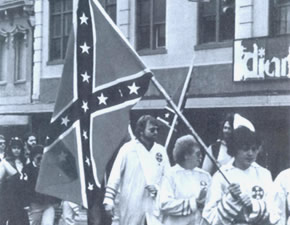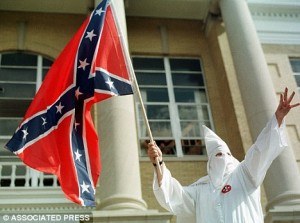
By Scott St. Clair | The Save Jersey Blog
It’s time for the Confederate battle flag to come down. After the Charleston massacre, and especially after the grace, humility, forgiveness and love shown by the grief-stricken people of Emmanuel African Methodist Episcopal Church and as a gesture of reconciliation – call it a unilateral act of understanding – it needs to be retired from official public life. It’s time — yesterday it wasn’t, today it is, tomorrow it will be too late.
In the wake of the tragedy, South Carolina Gov. Nikki Haley, a Republican, called for the removal the flag from the grounds of the state Capitol in Columbia. Joining her in that call were the state’s two Republican U.S. senators, Lindsey Graham and Tim Scott, who is black.

Gov. Haley was quoted saying, “Today, we are here in a moment of unity in our state, without ill will, to say it is time to move the flag from the Capitol grounds… (This) is a moment in which we can say that the flag, while an integral part of our past, does not represent the future of our great state.”
Alabama Gov. Robert Bentley, like Gov. Haley, a Republican, followed suit this week by ordering the removal of four Confederate battle flags from his state capitol campus.
Mississippi’s state House Speaker Phillip Gunn, also a Republican, supported redesigning the state’s flag to remove an image of the battle flag. Quoted in The New York Times, he said, “We must always remember our past, but that does not mean we must let it define us…As a Christian, I believe our state’s flag has become a point of offense that needs to be removed.”
No national Republican political figure of any consequence has taken up flag’s cause. If anything, they’re either calling for its removal (see also here) or dodging the issue because they know it’s political poison.
“There is a time for everything, and a season for every activity under the heavens: a time to be born and a time to die, a time to plant and a time to uproot…” Ecclesiastes 3:1-2 (NIV). Since the last surviving Confederate veteran of the Civil War died in 1951 while the Charleston nine are still being buried, it’s time to uproot.
Flags are symbols – they represent something, they send a message, they can unify or divide. Arguably, the Confederate battle flag carried by soldiers during the Civil War once stood for something noble, but today the message it carries is too mixed, muddied and painful to do anyone proud, especially when displayed with the government’s blessing at a state capitol, in the state flag or on state-issued license plates.
While people hang on to lost causes more tightly than winning ones, which explains southern zeal and relative northern indifference to Civil War history, its symbols can still be two-edged swords. Some years ago, I sat on a jury in an ugly rape case that featured extensive methamphetamine use and other criminal activity by everyone involved. A photograph of the defendant’s bedroom was introduced into evidence, but it had a significant portion of it cut out, and we weren’t told why until after the trial where we convicted him and his accomplice. It turns out he had a Confederate battle flag hanging on the wall, and the defense insisted that portion of the photo be excised lest it enflame the jury.
In my own family, where my great-grandfather on my mother’s side was a Union soldier who fought at Gettysburg and was subsequently severely wounded at Cold Harbor, the feeling was strong among his daughters, my grandmother and great-aunt, that Confederates were traitors and that things Confederate, Civil War-replica gray hats, for example, were not to be tolerated in their homes with the wearing of one grounds to eject the wearer from the house. I opted to get a blue hat instead, because, as my mother told me, even in 1960, Auntie Mae brooked neither traitors nor their sympathizers.
And exactly how well-grounded in history are some who fly that flag? Writer Tony Horwitz did a detailed examination of the lingering effects of the Civil War in the South in his book, Confederates in the Attic, one of the most insightful cultural analyses I’ve ever read. It included a lengthy look at the effect the Confederate battle flag had on a small town in southern Kentucky.
 During a previous argument over the battle flag raged in South Carolina, this time over whether it should fly over the state Capitol building, a good ol’ boy, whose uniform de jour consisted of “black Levis, black cowboy hat, cowboy boots and a huge silver-plated belt buckle,” who drove “a big red Chevy 4X4 with a jacked-up chassis, a rebel-flag license plate, and a large rebel flag flapping from a pole in the truck’s bed” made possible because “he used his welding skills to attach a flag pole to the diamondback toolbox in the bed of his pickup,” attracted the ire of several black young men one evening – some said he yelled the “N” word at them – to the point where one of them shot and killed the ol’ boy.
During a previous argument over the battle flag raged in South Carolina, this time over whether it should fly over the state Capitol building, a good ol’ boy, whose uniform de jour consisted of “black Levis, black cowboy hat, cowboy boots and a huge silver-plated belt buckle,” who drove “a big red Chevy 4X4 with a jacked-up chassis, a rebel-flag license plate, and a large rebel flag flapping from a pole in the truck’s bed” made possible because “he used his welding skills to attach a flag pole to the diamondback toolbox in the bed of his pickup,” attracted the ire of several black young men one evening – some said he yelled the “N” word at them – to the point where one of them shot and killed the ol’ boy.
The shooter and one accomplice were subsequently convicted of murder, while the victim was lionized by locals as an honorary Confederate and martyr to the cause of Southern rights and independence.
But when asked why he flew that flag, the victim’s widow said, “He’d do anything to make his truck look sharp. The truck’s red. The flag’s red. They match.” One of his long-time pals said of the victim’s knowledge of the battle flag’s history and symbolism, “I don’t think he knowed the history of it.”
So much for Southern Heritage.
Retailers are pulling battle flag-themed merchandise from their shelves, a merchandising decision they’re making on their own. Nobody should insist that government at any level force them to do it. Company officials, I suspect, are seeing the flag as something that’s too galvanizing and controversial – they’re in the business of making money, not political statements – so they’re anticipating the market’s regard of the flag as something toxic. Business people have a knack for getting ahead of the curve.
Despite what some say and predict, uprooting the battle flag isn’t the first in a series of dominoes to fall that will result in the erasure of all mention of the people or events of the Civil War from the public landscape and memory. If we do that, intentionally forget our history, we’ll be doomed to repeat it, so nobody’s going to change the name of Fort Bragg anytime soon.
Sure, there will be politically-motivated efforts to de-history the South, but they will fail since the cynicism that drives them will fritter away once the next big issue comes along. But the battle flag, in light of Charleston, is different.
Nor is this a false-flag incident designed to distract us from bigger, more important things going on in Washington, D.C. and around the world. The issue has been simmering for years, Charleston brought it to a head and we can multi-task and entertain multiple thoughts and conundrums at once.
True, the Confederate battle flag isn’t the only symbol of oppression floating around. But to argue that it should stay up until the others have come down advances the notion that no wrong should be corrected until all wrongs are corrected at once. Exactly how does that resolve anything?
Nit picking over the flag’s historic jots and tittles – it was a battle flag, not the national flag of the Confederacy; it never meant the Ku Klux Klan and Jim Crow-racism, it meant southern heritage and pride – means nothing today. Distinctions without differences, rationalizations rather than reasons to keep it.
Scholar Victor Davis Hanson, writing at NationalReview.com, rebutted the heritage argument: “Perhaps we should step back and eschew symbolism that separates us by race rather than unites us as fellow citizens.”
Then he asked:
Whether implicit state endorsement of Confederate symbolism offers sanction for the old idea of an apartheid nation, and thus sends entirely the wrong message of American separatism rather than unity. While many Southerners object that the flag simply proclaims the battlefield honor of those who were defending their homeland, the Confederacy was so entwined with the idea of preserving slavery that the flag, even today, can evoke racial polarization. For all the Southern patriots who understandably see in the Confederate battle flag the historical resonance of Pickett’s Charge or the resistance to Sherman’s March to the Sea, there are probably just as many who equally understandably consider it a nostalgic icon of white supremacy. In a racially diverse society, it makes sense to phase out state sanction for the battle flag…”
Even a senior official of the ultra-conservative Southern Baptist Convention weighed in favoring removal. Russell Moore, president of the Ethics and Religious Liberty Commission of the SBC, wrote:
The Confederate Battle Flag may mean many things, but with those things it represents a defiance against abolition and against civil rights. The symbol was used to enslave the little brothers and sisters of Jesus, to bomb little girls in church buildings, to terrorize preachers of the gospel and their families with burning crosses on front lawns by night…The cross and the Confederate flag cannot co-exist without one setting the other on fire.”
The evidence is in, the trial is over and the verdict has been rendered.
A new Rasmussen Poll has 60 percent of voters agreeing that South Carolina should take down the Confederate battle flag that flies on the grounds of the state Capitol, with only 20 percent opposed. The train has left the station.
June 17, 2015, the day of the Charleston massacre, is like December 7, 1941 or September 11, 2001. Our views of the world on the day before and on the day after are 180-degree opposite.
A Duke University political scientist was quoted in The New York Times saying, “To see all of this happening, all of a sudden, it speaks of some fundamental change in the country. It is surprising in the sense that there have been calls for this for years. But it took (Charleston) to spur this type of change.”
Yesterday was another time. The great Civil War historian, Shelby Foote, remarked in the Ken Burns documentary The Civil War on how southerners live as if they’re in a William Faulkner novel reliving glorious times in the antebellum South in a way that allows them to possibly change the course of history.
But novels are works of fiction, and the truth now belies Foote’s and Faulkner’s idealized notion almost to the point where the South is becoming a function of geography, not of heritage. Demographics and the marketplace are seeing to that.
This is apostasy to some, but given the transitory nature of American life and its mobile population, if you do the math and look down the road you can’t help but see it.
According to the Census Bureau, South Carolina has a population of nearly 5 million people, of whom 68.3 percent are white and 27.9 percent are black. There’s a growing Latino population – 5.3 percent – and a mix of others. But where were they born? Are they native South Carolinians whose heritage includes the events of the Civil War, or are they, to borrow a post-Civil War pejorative term for outsiders coming in, “carpetbaggers”?
According to an analysis by The New York Times, native-born South Carolinians represent 58 percent of its population. In 1950, however, the native-born contingent made up 87 percent. Another analysis pegs the native-born percentage at 64 percent putting the state at about the middle of the national pack when it comes to people living in the state of their birth. What will the numbers be in another 65 years?
The percentages for other southern states vary – Louisiana with 79 percent native-born leads the nation, while Florida with 36 percent native-born is the lowest in the south – but the overall trend from 1950 to the present is pretty clear: The South as we’ve historically understood it is decreasingly southern demographically and more something else.
North Carolina, also a state of the Old South and one of the fastest growing states along the eastern seaboard, is going through an even more dramatic demographic change. There, almost half the electorate was born somewhere other than the Tar Heel State.
It’s still true that, according to the Census Bureau, “Most people in the United States live in the state in which they were born,” it’s also true that, “The U.S. population is characterized by high mobility. Each year many Americans leave their place of birth to reside in a different part of the country.”
States like New York, New Jersey, Illinois and California are all shedding residents like a snake sheds its skin. Many end up relocating to the South. Ol’ Granddaddy would hardly recognize the place.
South Carolina, together with other southern states like Arkansas, Florida North Carolina, Tennessee and Virginia attract residents from out of state in strong numbers, and these new residents come from parts of the country that wouldn’t be expected to be sympathetic to the Southern Cause of 1861-1865. Also, deep-South states such as Louisiana and Mississippi, while not attracting large numbers of out-of-region new residents, sit atop the list of states that export residents, indicating diminishing influence over the long term. (Excellent graphic representations of these demographic shifts can be found here and here).
 The available data suggests not just a population shift, but also a cultural one. People bring with them their own beliefs, heritage and attitudes when they move. Those whose people fought for the Union aren’t about to check that history at the South Carolina state line to take up a history to which they’re indifferent or even hostile. And descended of post-Civil War immigrants are likely to remain indifferent to a clarion call to relive past battlefield glories and defeats.
The available data suggests not just a population shift, but also a cultural one. People bring with them their own beliefs, heritage and attitudes when they move. Those whose people fought for the Union aren’t about to check that history at the South Carolina state line to take up a history to which they’re indifferent or even hostile. And descended of post-Civil War immigrants are likely to remain indifferent to a clarion call to relive past battlefield glories and defeats.
With attractive business climates, national and multi-national companies see states like South Carolina, which aggressively pursues national and international investment, as places in which they wish to do business. German-owned BMW, for example, is the state’s third-largest private employer. Chicago-based Boeing has aggressively grown in the state to where it will soon employ in excess of 7,500 people. Companies such as these have no interest in playing cultural politics.
Behind-the-scenes pressure from the South Carolina’s business community, including BMW, Boeing, South Carolina-based Michelin North America and every good ol’ boy’s favorite, North Carolina-based NASCAR, which had banned the Confederate battle flag a long time ago, made it clear in no uncertain terms that they were firmly in favor of getting rid of the flag.
A quick glance at the South Carolina-based companies on Inc.com’s list of the 5,000 fastest growing companies in America reveals a plethora of technology, business and financial-services, travel and hospitality and other companies that are not likely to want to an issue like this in their state. Computer geeks aren’t known for engaging in Faulknerian fantasies other than in video games.
Why would they – why would anyone want to even remotely associate with a symbol so blatantly and flagrantly flaunted by the alleged Charleston shooter, Dylann Roof, who gloried in both the Confederate battle flag and the deaths of black people to the point where the two were inextricably intertwined?
Consider him, his alleged crime and his rambling, hate-filled, racist manifesto (what’s purported to be the original can be found here) as the straw that broke the camel’s back.
My wife, the most southern lady to be found on the face of the earth, 15 years in New Jersey notwithstanding, hit the Dylann Roof-nail on its head:
The heinous devil who committed that terrible act will receive, as a penance, the loss of his beloved Confederate flag. He may never be sad about the death of those people, but he’ll be sad about the taking down of that flag. While I don’t think of slavery, but of a southern way of life, when I see it, I know it has to go.”
If you’re outraged at the removal of the battle flag from the South Carolina Capitol campus or other moves directed toward Confederate symbols and monuments, blame Dylann Roof and others like him. And then look in the mirror and ask yourself how many times you opposed its use by someone like Roof, the KKK or others as an emblem of racism, hate and, in too many cases, including Charleston’s, death?
A former Mississippi commander of the Sons of Confederate Veterans acknowledged this truth in the aftermath of the Charleston massacre when he was quoted saying, “”A lot of our problems are because we didn’t stand up and say, ‘No, enough is enough’ when they were doing that.”
Ask yourself: does the Confederate battle flag, as a symbol, unite us or divide us? And then ask whether it’s more unity we need, or more division? The answer ought to be self-evident.
To respect the newly-dead and, in Lincoln’s words, “to bind up the nation’s wounds,” let’s just do this – uproot that flag.
________



I might feel more supportive if this also applied to any Nazi symbolism. But that is all still out there, in spite of its representing genocide and attempted world domination.
You can tell a southerner to “get over it” when it comes to the civil war but you can’t tell a black person to “get over it” when it comes to slavery that happened at the same time as the civil war. If not for the double standards we’d have none, right?
Are you going to go down to Charleston and tell them to “get over it”?
Sound argument. Remove the flag from public property, put it in a museum or historical setting. It is, after all, a part of our history. However, what happens when the political correctness creeps further into the historical context and the flag is banned in that capacity? Gettysburg, PA is the sight of the battle that bears it’s name, the turning point of the ACW. Reenactors and living historians gather by the thousands every year to take part in programs and battle reenactment to educate and memorialize this epic struggle. Historically accurate weapons, uniforms, equipment and flags are used on every capacity from one on one interaction to battle simulations involving thousands of “soldiers” and spectators. For all intents and purposes the entire town of Gettysburg is a museum with monuments not only cover the NPS battlefield but dotted through the town that was engulfed in that 3 day struggle. What does it say when in one of the most historic paced in America where history is celebrated daily, an historical symbol is banned from view and use by living historians because it might offend some one? A group of Confederate reenactors was told by the organization that invited them to camp for the weekend and teach the public about Civil War soldiers and their everyday life, that they could NOT display the battle flag. We remember, teach and celebrate history for many reasons, the most important of which is so we learn from our past. Erasing what is dark because it might offend is wrong and has only been done by despots bent on controlling the thoughts of a people. In fact ISIS is erasing the history of those they have conquered. They didn’t put things in a museum, in fact they destroyed the museums.
Are book burnings going to be next? No one should forget that Bill Clinton’s old campaign materials had many depictions of the Battle Flag of the Army of Northern Virginia. People, local and state governments should be able to show or not show whatever flag they want but this anti flag hysteria has gone much too far. You can no longer buy the flag on Amazon or at Civil War museums. Some idiots want to ban Gone With the Wind. Obama and his supporters have transformed America. They have made it a hate filled place where if you don’t agree with their narrow view of diversity you are attacked.
Quick clarification, the picture posted of that demented creature holding a Confederate flag is NOT the “Stars and Bars” which refers to the first official flag of the Confederacy. That creature is holding a replica of the Confederate naval jack which is emblazoned with the Southern Cross and 11 stars representing the Confederate states. The flag in question flying in South Carolina is the battle flag of the Army of Northern Virginia. History is important, even if it is only to be erased by ignorance and political correctness.
Read my article. Throughout, I refer to it as the “Confederate battle flag” or “battle flag,” not the Stars and Bars.
The ignorance is in a willingness to ignore and refusal to acknowledge how that particular flag was used to justify the persecution, denial of rights, physical harm and even death to a substantial portion of the population. It’s not political correctness to respect the truth and take it down — it’s good manners.
You’ll note that NOBODY of any consequence on the right, either politically or in the church community, is opposing the growing movement to have it removed from governmental display. If anything, they are fully in support.
It funny what it took to get people to make the connection. The flag went up in71 just when Civil Rights was taking hold. Sort of ” yah, you’ll go ahead but just remember…”